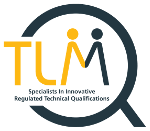TLM qualification design rationale
Background to the Design
The approach to assessment has evolved significantly over the years, particularly with the introduction of competency-based frameworks such as the Regulated Qualifications Framework (RQF). Historically, qualifications relied on norm-referenced grading through controlled handwritten examinations. However, contemporary vocational and technical education has increasingly embraced criterion-referenced assessment, ensuring learners meet defined benchmarks rather than being compared against cohort performance distributions.
The design of our qualifications reflects a modern, flexible, and inclusive approach, ensuring valid and reliable assessment while supporting learner progression and motivation.
Key Considerations in Assessment Design
1. Purpose and Validity of Assessment
Assessments should align with their intended purpose, avoiding unnecessary complexity or extraneous demands that do not support meaningful learning. The three primary purposes of assessment are:
- Measuring competence: Ensuring learners can demonstrate the required skills and knowledge to a specified standard.
- Facilitating progression: Identifying readiness for higher levels of study or employment opportunities.
- Encouraging motivation and engagement: Using assessment as a tool to support learning, rather than as a barrier.
The design ensures that competency-based criteria are at the heart of the assessment process, while graded elements allow differentiation where required.
2. Ensuring Assessment Relevance and Breadth
Assessment design must reflect the nature of the subject being assessed. For knowledge-based subjects, a written examination may be sufficient. However, for applied skills, a broader assessment approach—incorporating practical demonstration, real-world applications, and holistic evaluation—is essential.
For example:
- Language assessment must include speaking, listening, reading, and writing rather than relying solely on written exams.
- Technical qualifications should assess applied competencies within realistic industry contexts rather than using artificial or overly controlled environments.
3. Avoiding Assessment-Led Learning Constraints
Poorly designed assessments can limit learning by encouraging teaching to the test rather than deep understanding. Our qualification design mitigates this by:
- Focusing on real-world competence rather than exam techniques.
- Ensuring assessments do not create unnecessary administrative burdens that detract from teaching and learning.
- Encouraging flexibility so that high-achieving learners can progress without artificial constraints based on age or key stage expectations.
4. Integrity and Trust in Assessment
All assessments carry risks, including:
- Misalignment between assessment and actual competence.
- Dishonest assessment practices by learners or assessors.
- Unjustified precision in grading.
To maintain integrity, our approach includes:
- Robust assessor training and accountability to uphold consistency and fairness.
- Competency-based coursework alongside external validation mechanisms, ensuring learners are genuinely meeting required standards.
- Use of digital evidence management to facilitate transparency and moderation.
5. Recognising Uncertainty in Grading
Grading in qualifications should reflect genuine differentiation in performance. However, overly fine grading lacks statistical reliability. Our approach addresses this by:
- Using competency-based pass/fail criteria for foundational knowledge and skills.
- Incorporating graded assessments for differentiation at higher levels, ensuring performance distinctions are meaningful.
- Benchmarking assessments against comparable qualifications to maintain consistency in difficulty and reliability.
Design Principles of Our Qualifications
A. Purpose of Level 1-3 Qualifications
Our qualifications serve multiple purposes, including:
- Recognising key learning milestones to support motivation and progression.
- Ensuring structured learning pathways with clear progression routes.
- Supporting stakeholder decision-making regarding learner readiness for further study or employment.
- Facilitating school and provider accountability while minimising administrative burden.
B. Structuring Learner Progression
1. Progression through Content
Competency-based coursework tracks progress through structured learning programmes. This ensures:
- Learners develop foundational skills before progressing to graded elements.
- Assessment focuses on real-world applications rather than arbitrary age-based benchmarks.
- High-achieving learners can progress at their own pace, rather than being constrained by standardised age expectations.
2. Progression through Grading
To accommodate diverse learner needs, our model:
- Ensures all learners meeting competency standards can progress.
- Uses graded assessments to identify higher-level academic potential.
- Allows flexible exam timing, ensuring learners are assessed when they are genuinely ready rather than at a fixed point.
C. Maintaining Validity and Flexibility
By allowing assessors to gather evidence through a range of methods, we ensure:
- Assessments align with real-world tasks rather than artificial constructs.
- Teacher assessors have the flexibility to evaluate learner competence within authentic learning environments.
- Qualification delivery is adaptable to different learning models, whether unit-based, linear, or modular.
D. Addressing Assessment Risks and Integrity
We mitigate risks related to teacher-assessed coursework by:
- Requiring coursework completion before graded exams, ensuring practical competence is demonstrated.
- Implementing assessor accountability agreements, ensuring adherence to quality standards.
- Using external moderation triggers based on learner performance trends, allowing proactive quality assurance.
E. Managing Grade Inflation and Qualification Standards
Grade inflation has been a long-standing concern in the education sector. Our approach:
- Recognises the importance of maintaining rigorous grading standards.
- Uses statistical benchmarking to ensure comparability with other qualifications.
- Provides mechanisms for gradual adjustments to assessment difficulty, ensuring qualifications remain fit for purpose.
Summary
Our qualification design prioritises:
- Competency-based assessment that reflects genuine learner capabilities.
- Flexible learning progression that avoids unnecessary constraints.
- A balance between coursework and graded assessment, ensuring validity while reducing administrative burden.
- A robust integrity framework to maintain public confidence in assessment outcomes.
By aligning with modern assessment principles under the RQF, our approach supports effective teaching, motivates learners, and ensures qualifications are credible and meaningful for all stakeholders.

